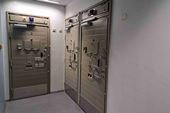Cameras installed in industrial or marine settings are constantly exposed to harsh chemicals, salt, or other corrosive materials. For these reasons, inner camera components that can be easily damaged in these kinds of environments need to be enclosed in strong, protective housings.
Until recently, anti-corrosion cameras used housings made of metal, typically stainless steel or coated aluminum. While these materials can be very effective in terms of protecting sensitive camera components, they are also typically expensive and heavy, making them more difficult to handle and install.
To overcome these challenges, the latest generation of anti-corrosion cameras use reinforced polyamides, which are light, highly durable and more cost effective than metal housing alternatives. Read on to find out why these cutting-edge materials are a game changer for anti-corrosion cameras in four key ways.
- Resilience against various kinds of chemicals and corrosive materials
In the process of corrosion, oxygen, acids, salt and other substances convert metals into more chemically stable oxides. This can damage them and prevent them from fulfilling their intended function, requiring metal components to be treated or coated with special chemicals.
Reinforced polyamides require no such protection as they are almost immune to corrosion. The secret behind this is the strong chemical bonds that hold polyamides together, as well as the extra reinforcement provided by the blended materials. The tight molecular structure of the polyamides provides greater stability and durability, leaving very little chemical energy available to react with other substances, even the most aggressive oxidants.
According to the British Plastics Federation, polyamides provide good resistance to most chemicals. Hikvision's rigorous acid, alkali, and salt spray tests have proved that a polyamide, when reinforced, can exhibit exceptional material integrity. - Protection against abrasion, impacts, and the passage of time
Naturally present in wool and silk, polyamides are more often seen in synthetic products. Sports gear and dental floss demonstrate the reliability and strength of these materials, which are also used frequently to replace metal components in all kinds of machinery and equipment.
In a Hikvision laboratory test, a specific reinforced polyamide demonstrated 90% of the strength of aluminum. Notably, it was able to withstand repeated high-energy impacts with no signs of fracture, demonstrating its suitability for high-demand security scenarios and devices.
Reinforced polyamides are also strong enough to resist the ravages of time. Subjected to rigorous 1,000-hour xenon aging tests in the Hikvision lab, the tested reinforced polyamide maintained its appearance and resilience in a way that regular plastics are unable to. - Reduced camera weight and less hassle for installers
Heavy stainless-steel-cladded cameras, which typically weigh up to 25 kg, are difficult for installers to handle safely. In many cases, it is simply impossible for a single person to do the installation. The same volume of reinforced polyamides are significantly lighter than their metal counterparts. A reinforced polyamide typically has a density less than half that of aluminum and only a seventh of stainless steel.
This weight differential changes the game for installers, making anti-corrosion cameras much less cumbersome and much easier to install and maintain. - New levels of cost effectiveness
Reinforced polyamides are typically far more cost effective than metals. Their lighter weight also provides significant savings in terms of transportation, warehousing, and installation costs. The superior durability of reinforced polyamides in harsh environments also reduces the need for repairs and maintenance, delivering major savings for larger installations on public roadways, in industrial parks, or in similar settings.
Security cameras with reinforced polyamide housings offer excellent performance and durability at a highly competitive price-point. This makes them an excellent investment for users and helps to maximize ROI over the product lifecycle.
Introducing Hikvision’s reinforced polyamide anti-corrosion cameras
Hikvision’s newly released Polymer Anti-Corrosion Cameras feature state-of-the-art reinforced polyamide housings and accessories. They increase durability and cost effectiveness for customers, as well as reducing the weight of each camera unit. Additionally, the cameras are equipped with Hikvision Colorvu and Darkfighter technologies for effective colour imaging, even in ultra-low light.
A range of built-in deep learning analytics capabilities help end users to maximize security and reduce false positives. Additionally, third-party or custom applications can be integrated easily into the cameras, making them ideal for even the most complex security needs.
The new Hikvision anti-corrosion cameras, which are wrapped in tried-and-tested reinforced polyamide, promised to be a durable, lightweight, cost-effective security solution, even in the harshest industrial and marine environments.

















